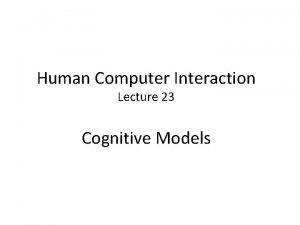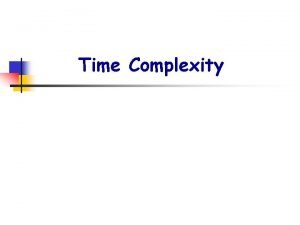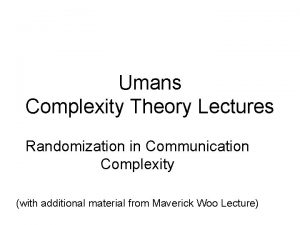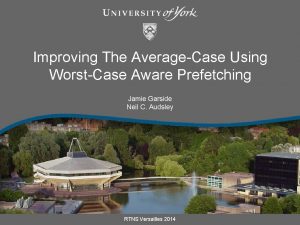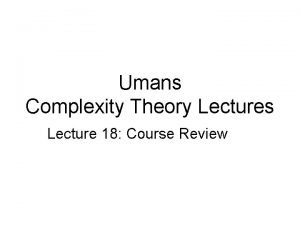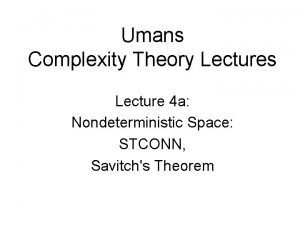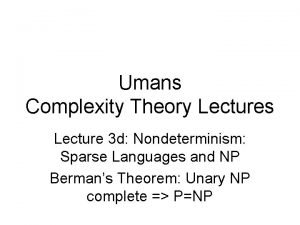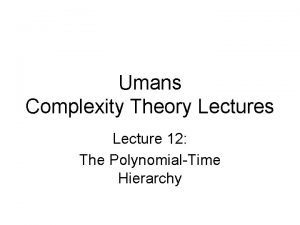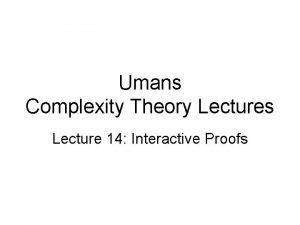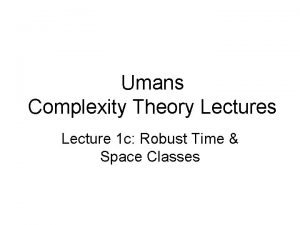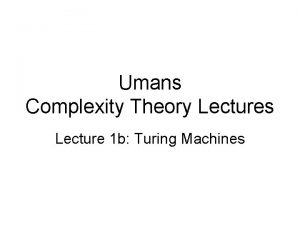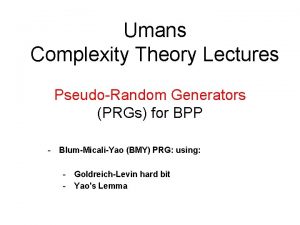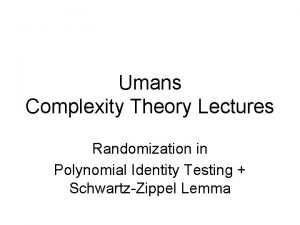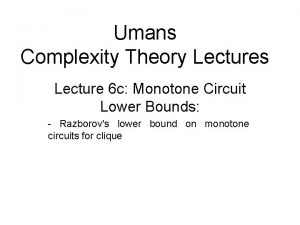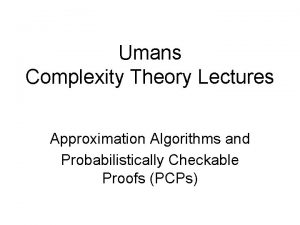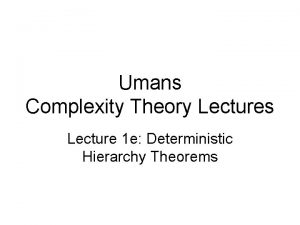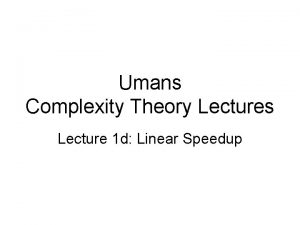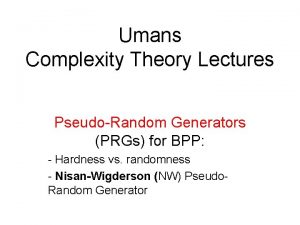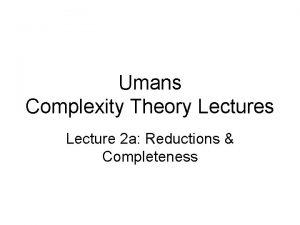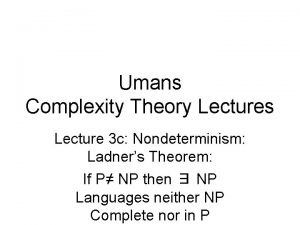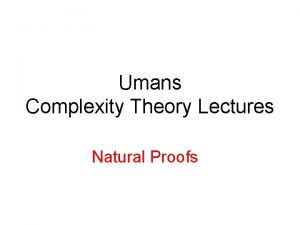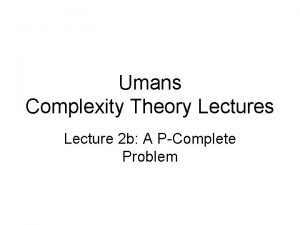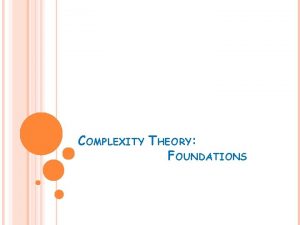Umans Complexity Theory Lectures Worstcase vs Averagecase using


















![Encoding m: 0 1 1 0 0 0 1 0 F qt Emb: [k] Encoding m: 0 1 1 0 0 0 1 0 F qt Emb: [k]](https://slidetodoc.com/presentation_image_h2/4da7b4b865e07b1ab570bda91ac6825c/image-19.jpg)
















- Slides: 35

Umans Complexity Theory Lectures Worst-case vs. Average-case using Error-Correcting Codes: Transforming worst-case hardness into average-case hardness

Unapproximability Assumption Definition: The function family f = {fn}, fn: {0, 1}n {0, 1} is s(n)-unapproximable if for every family of size s(n) circuits {Cn}: Prx[Cn(x) = fn(x)] ≤ ½ + 1/s(n). Nisan-Wigderson (NW) gave a Pseudo. Random Generator, which implies Theorem (NW): if E = k. DTIME(2 kn) contains 2Ω(n)-unapproximable functions then 2 BPP = P.

Unapproximability Assumption • How reasonable is unapproximability assumption? • Hope: obtain BPP = P from worst-case complexity assumption – try to fit into existing framework without new notion of “unapproximability” 3

Worst-case vs. Average-case Let E = k. DTIME(2 kn) Theorem (Impagliazzo-Wigderson, Sudan-Trevisan-Vadhan) If E contains functions that require size 2Ω(n) circuits, then E contains 2Ω(n) –unapproximable functions. • Proof: – Main proof tool: error correcting code 4

Error-correcting codes • Error Correcting Code (ECC): C: Σk Σn • message m Σk C(m) • received word R R – C(m) with some positions corrupted • if not too many errors, can decode: D(R) = m • parameters of interest: – rate: k/n – distance: d = minm m’ Δ(C(m), C(m’)) 5

Distance and error correction • C is an ECC with distance d • can uniquely decode from up to d/2 errors Σn d 6

Distance and error correction • Can find short list of messages (one correct) after closer to d errors! Theorem (Johnson): a binary code with distance (½ - δ 2)n has at most O(1/δ 2) codewords in any ball of radius (½ - δ)n. 7

Reed-Solomon Code • alphabet Σ = Fq : field with q elements • message m Σk • polynomial of degree at most k-1 pm(x) = Σi=0…k-1 mixi • codeword C(m) = (pm(x))x Fq • rate = k/q 8

Reed-Solomon Code • Claim: distance d = q – k + 1 – suppose Δ(C(m), C(m’)) < q – k + 1 – then there exist polynomials pm(x) and pm’(x) that agree on more than k-1 points in Fq – polnomial p(x) = pm(x) - pm’(x) has more than k -1 zeros – but degree at most k-1… – contradiction. 9

Reed-Muller Code • Parameters: t (dimension), h (degree) • alphabet Σ = Fq : field with q elements • message m Σk • multivariate polynomial of total degree at most h: pm(x) = Σi=0…k-1 mi. Mi {Mi} are all monomials of degree ≤ h 10

Reed-Muller Code • Mi is monomial of total degree h – e. g. x 12 x 2 x 43 – need # monomials (h+t choose t) > k • codeword C(m) = (pm(x))x (Fq)t • rate = k/qt • Claim: distance d = (1 - h/q)qt – proof: Schwartz-Zippel: polynomial of degree h can have at most h/q fraction of zeros 11

Codes and hardness • Reed-Solomon (RS) and Reed-Muller (RM) codes are efficiently (polynomial time) encodable • Efficient unique decoding? – yes (classic result) • Efficient list-decoding? – yes 12

Codes and Hardness • Use for worst-case to average case: truth table of f: {0, 1}log k {0, 1} m: 0(worst-case 1 1 0 0 0 hard) 1 0 truth table of f’: {0, 1}log n {0, 1} (average-case hard) Enc(m): 0 1 1 0 0 0 0 1 0 If n = poly(k) then f E implies f’ E where E = k. DTIME(2 kn) 13

Codes and Hardness • Want to be able to prove: if f’ is s’-approximable, then f is computable by a size s = poly(s’) circuit 14

Codes and Hardness • Key: circuit C that approximates f’ implicitly gives received word R R: 0 0 1 0 1 0 0 Enc(m): 0 1 1 0 0 0 0 1 0 • Decoding procedure D “computes” f exactly • Requires special D C notion of efficient decoding 15

Codes and Hardness f: {0, 1}log k {0, 1} f ’: {0, 1}log n {0, 1} m: 0 1 1 0 0 0 1 0 Enc(m): 0 1 1 0 0 0 0 1 0 R: 0 0 1 0 1 0 0 decoding procedure i ∈ {0, 1}log k D C small circuit C approximating f’ small circuit that computes f exactly f(i) 16

Encoding • Use a (variant of) Reed-Muller code concatenated with the Hadamard code – q (field size), t (dimension), h (degree) • Encoding procedure: – message m ∈ – subset S ⊆ Fq of size h {0, 1}k so, need ht ≥ k – efficient 1 -1 function Emb: [k] → St – find coeffs of degree h polynomial pm: Fqt → Fq for which pm(Emb(i)) = mi for all i (linear algebra) 17

Encoding • Encoding procedure (continued): – Hadamard code Had: {0, 1}log q → {0, 1}q • Is Reed-Muller with field size 2, dim. log q, deg. 1 • distance ½ by Schwartz-Zippel Theorem – Final codeword: (Had(pm(x)))x ∈ Fqt • evaluate pm at all points, and encode each evaluation with the Hadamard code 18
![Encoding m 0 1 1 0 0 0 1 0 F qt Emb k Encoding m: 0 1 1 0 0 0 1 0 F qt Emb: [k]](https://slidetodoc.com/presentation_image_h2/4da7b4b865e07b1ab570bda91ac6825c/image-19.jpg)
Encoding m: 0 1 1 0 0 0 1 0 F qt Emb: [k] → St St 5 2 7 1 2 9 0 3 6 8 3 pm degree h polynomial with pm(Emb(i)) = mi evaluate at all x ∈ Fqt encode each symbol. . . 0 1 0 1 0. . . with Had: {0, 1}log q→ {0, 1}q 19

Decoding Enc(m): 0 1 1 0 0 0 0 1 R: 0 0 1 0 1 0 0 0 1 0 • small circuit C computing R, agreement ½ + • Decoding step 1 – produce circuit C’ from C • given x → Fqt outputs “guess” for pm(x) • C’ computes {z : Had(z) has agreement ½ + /2 with x-th block}, outputs random z in this set 20

Decoding • Decoding step 1 (continued): – For at least /2 of blocks, agreement in block is at least ½ + /2 – Johnson Bound: when this happens, list size is S = O(1/ 2), so probability C’ correct is 1/S – altogether: • Prx[C’(x) = pm(x)] ≥ ( 3) • C’ makes q queries to C • C’ runs in time poly(q) 21

Decoding pm: 5 2 7 1 2 9 0 3 6 8 3 R’: 5 9 7 1 6 9 0 3 6 8 1 • small circuit C’ computing R’, • agreement ’ = ( 3) • Decoding step 2 – produce circuit C’’ from C’ • given x ∈ emb(1, 2, …, k) outputs pm(x) • idea: restrict pm to a random curve; apply efficient R-S list-decoding; fix “good” random choices 22

Restricting to a curve – points x= 1, 2, 3, …, r ∈ Fqt specify a degree r curve L : Fq → Fqt • w 1, w 2, …, wr are distinct elements of Fq • for each i, Li : Fq → Fq is the degree r poly for which Li(wj) = ( j)i for all j • Write pm(L(z)) to mean pm(L 1(z), L 2(z), …, Lt(z)) 2 x= 1 r 3 degree r·h·t univariate poly • pm(L(w 1)) = pm(x) 23

Restricting to a curve • Example: – pm(x 1, x 2) = x 12 x 22 + x 2 – w 1 = 1, w 2 = 0 1 = (2, 1) 2 = (1, 0) F qt – L 1(z) = 2 z + 1(1 -z) = z + 1 – L 2(z) = 1 z + 0(1 -z) = z – pm(L(z)) = (z+1)2 z 2 + z = z 4 + 2 z 3 + z 24

Decoding pm: 5 2 7 1 2 9 0 3 6 8 3 R’: 5 9 7 1 6 9 0 3 6 8 1 • small circuit C’ computing R’, agreement ’ = ( 3) • Decoding step 2 (continued): – pick random w 1, w 2, …, wr; 2, 3, …, r to determine curve L – points on L are (r-1)-wise independent – random variable: Agr = |{z : C’(L(z)) = pm(L(z))}| – E[Agr] = ’q and Pr[Agr < ( ’q)/2] < O(1/( ’q))(r-1)/2 25

Decoding pm: 5 2 7 1 2 9 0 3 6 8 3 R’: 5 9 7 1 6 9 0 3 6 8 1 • small circuit C’ computing R’, agreement ’ = ( 3) • Decoding step 2 (continued): – agr = |{z : C’(L(z)) = pm(L(z))}| is ≥ ( ’q)/2 with very high probability – compute using Reed-Solomon list-decoding: {q(z) : deg(q) ≤ r·h·t and Prz[C’(L(z)) = q(z)] ≥ ( ’q)/2} – if agr ≥ ( ’q)/2 then pm(L(·)) is in this set! 26

Decoding • Decoding step 2 (continued): – assuming ( ’q)/2 > (2 r·h·t·q)1/2 – Reed-Solomon list-decoding step: • running time = poly(q) • list size S · 4/ ’ – probability list fails to contain pm(L(·)) is O(1/( q))(r-1)/2 27

Decoding • Decoding step 2 (continued): – Tricky: • functions in list are determined by the set L(·), independent of parameterization of the curve • Regard w 2, w 3, …, wr as random points on curve L • for q pm(L(·s)) Pr[q(wi) = pm(L(wi))] · (rht)/q Pr[∀ i, q(wi) = pm(L(wi))] · [(rht)/q]r-1 Pr[∃ q in list s. t. ∀ i, q(wi) = pm(L(wi))] ·(4/ ’)[(rht)/q]r-1 28

Decoding • Decoding step 2 (continued): – with probability ≥ 1 - O(1/( q))(r-1)/2 - (4/ )[(rht)/q]r-1 • list contains q* = pm(L(·)) • q* is the unique q in the list for which q(wi) = pm(L(wi)) ( =pm( i) ) for i = 2, 3, …, r – circuit C’’: • hardwire w 1, w 2, …, wr; 2, 3, …, r so that ∀ x ∈ emb(1, 2, …, k) both events occur • hardwire pm( i) for i = 2, …r • on input x, find q*, output q*(w 1) ( = pm(x) ) 29

Decoding • Putting it all together: – C approximating f’ used to construct C’ • C’ makes q queries to C • C’ runs in time poly(q) – C’ used to construct C’’ computing f exactly • C’’ makes q queries to C’ • C’’ has r-1 elts of Fqt and 2 r-1 elts of Fq hardwired • C’’ runs in time poly(q) – C’’ has size poly(q, r, t, size of C) 30

Picking parameters • k truth table size of f, hard for circuits of size s • q field size, h R-M degree, t R-M dimension • r degree of curve used in decoding – ht ¸ k (to accomodate message of length k) – 6 q 2 > (rhtq) (for R-S list-decoding) – k[O(1/( q))(r-1)/2 + (4/ ’)[(rht)/q]r-1] < 1 (so there is a “good” fixing of random bits) – Pick: h = s, t = (log k)/(log s) – Pick: r = (log k), q = (rht -6) 31

Picking parameters • • • k truth table size of f, hard for circuits of size s q field size, h R-M degree, t R-M dimension r degree of curve used in decoding h = s, t = (log k)/(log s) log k, -1 < s -6 r = (log k), q = (rht ) Claim: truth table of f’ computable in time poly(k) (so f’ → E if f → E). – poly(qt) for R-M encoding – poly(q)·qt for Hadamard encoding – q · poly(s), so qt · poly(s)t = poly(h)t = poly(k) 32

Picking parameters • • • k truth table size of f, hard for circuits of size s q field size, h R-M degree, t R-M dimension r degree of curve used in decoding h = s, t = (log k)/(log s) log k, -1 < s -6 r = (log k), q = (rht ) Claim: f’is s’-approximable by C implies f computable exactly in size s by C’’, for s’ = s (1) – C has size s’ and agreement =1/s’ with f’ – C’’ has size poly(q, r, t, size of C) = s 33

Putting it all together Theorem 1 (IW, STV): If E contains functions that require size 2Ω(n) circuits, then E contains 2Ω(n) -unapproximable functions. (proof on next slide) Theorem (NW): if E contains 2Ω(n)-unapproximable functions then BPP = P. Theorem (IW): E requires exponential size circuits BPP = P. 34

Putting it all together • Proof of Theorem 1: – let f = {fn} be hard for size s(n) = 2δn circuits – define f’ = {fn’} to be just-described encoding of (the truth tables of) f = {fn} – two claims we just showed: • f’ is in E since f is. • if f ’ is s’(n) = 2δ’n-approximable, then f is computable exactly by size s(n) = 2δn circuits. – contradiction. 35
 Time and space complexity
Time and space complexity Tamara berg husband
Tamara berg husband Theory and practice of translation lectures
Theory and practice of translation lectures Theory of translation lectures
Theory of translation lectures Theory of translation lectures
Theory of translation lectures Cognitive complexity theory hci
Cognitive complexity theory hci Comprehension psychology
Comprehension psychology Minnesota complexity assessment method
Minnesota complexity assessment method L7 keystroke level
L7 keystroke level Rick trebino lectures
Rick trebino lectures Neonatology lectures
Neonatology lectures Data mining lectures
Data mining lectures Advanced medicinal chemistry
Advanced medicinal chemistry Uva powerpoint template
Uva powerpoint template Cs614 short lectures
Cs614 short lectures Planning a software project
Planning a software project Molecular biology lectures
Molecular biology lectures Radio astronomy lectures
Radio astronomy lectures Dr sohail lectures
Dr sohail lectures Utilities and energy lecture
Utilities and energy lecture Introduction to web engineering
Introduction to web engineering How to get the most out of lectures
How to get the most out of lectures Frcr physics lectures
Frcr physics lectures Rotating anode
Rotating anode Introduction to recursion
Introduction to recursion Guyton physiology lectures
Guyton physiology lectures Aerodynamics lecture
Aerodynamics lecture Power system lectures
Power system lectures Digital logic design lectures
Digital logic design lectures Jim kurose umass
Jim kurose umass What is hegelian philosophy
What is hegelian philosophy Nuclear medicine lectures
Nuclear medicine lectures Gpoint c++
Gpoint c++ Cdeep lectures
Cdeep lectures Oral communication 3 lectures text
Oral communication 3 lectures text C programming lectures
C programming lectures





